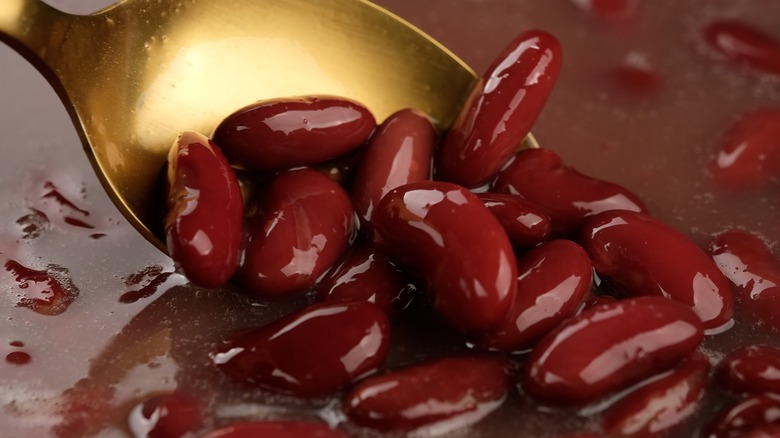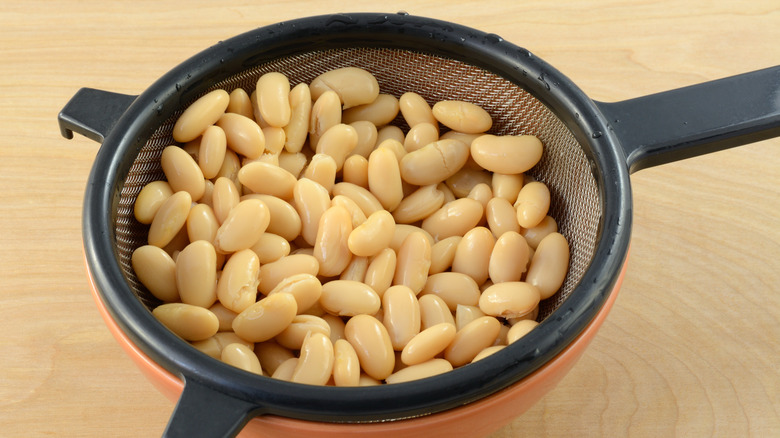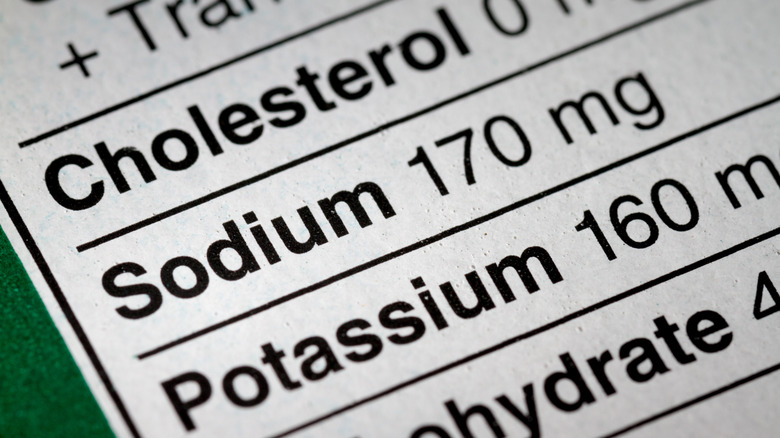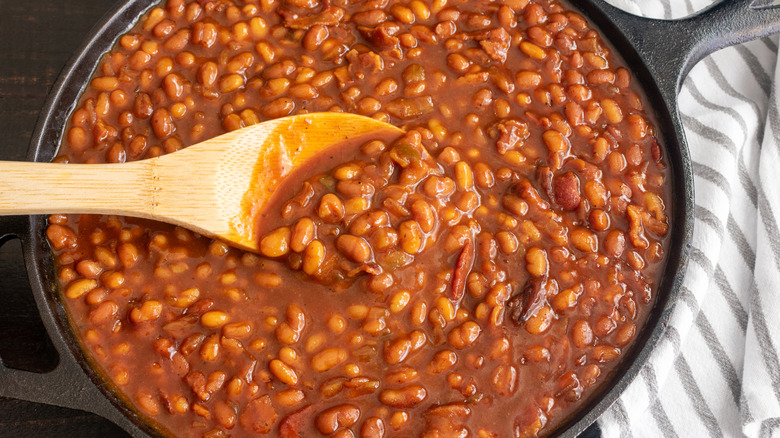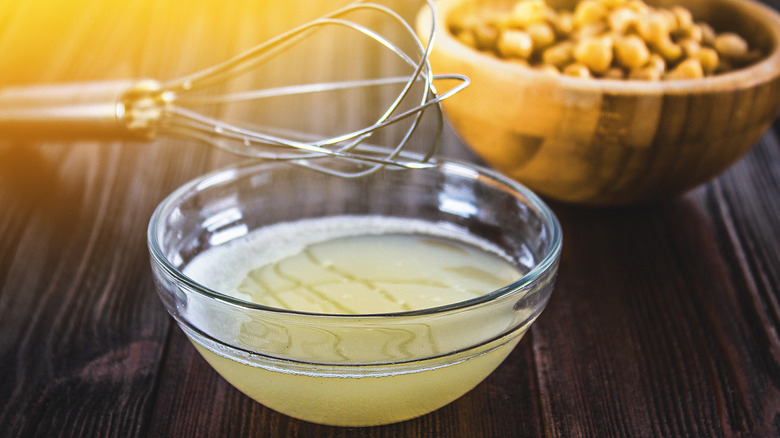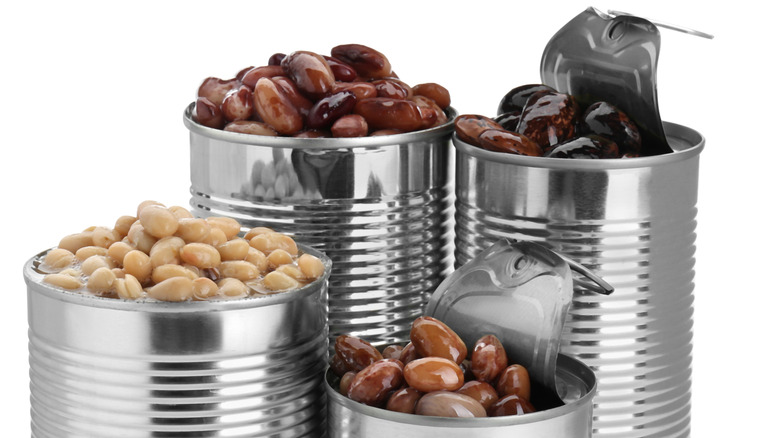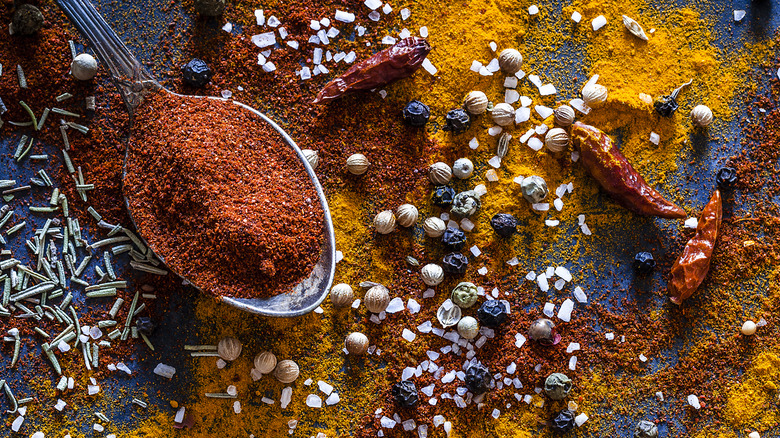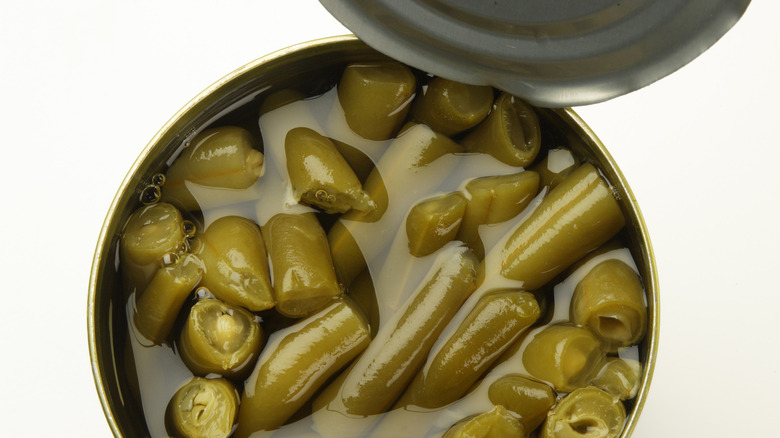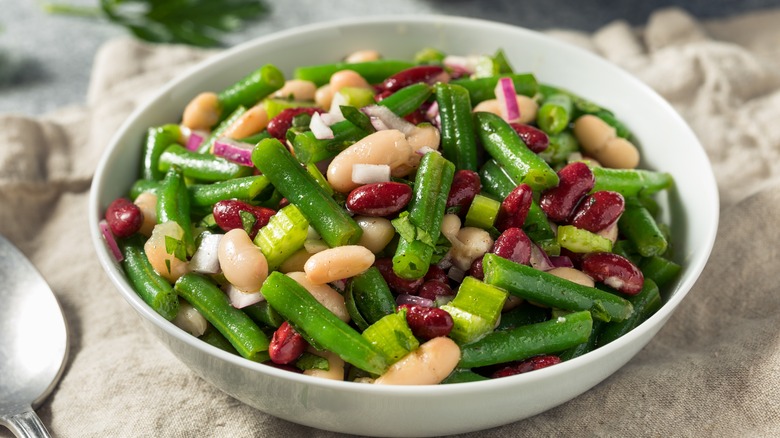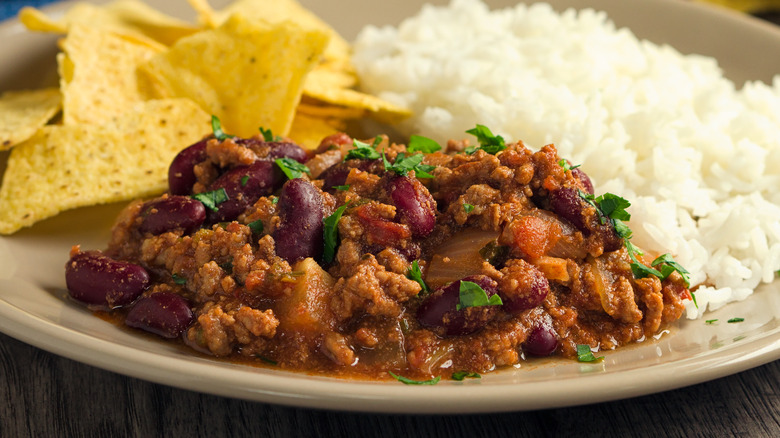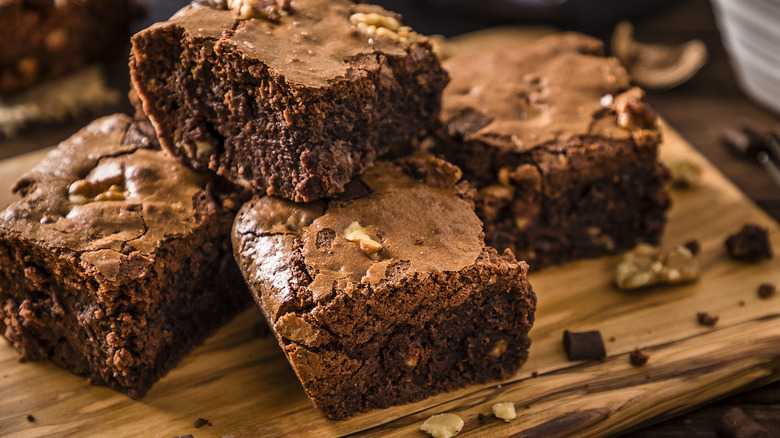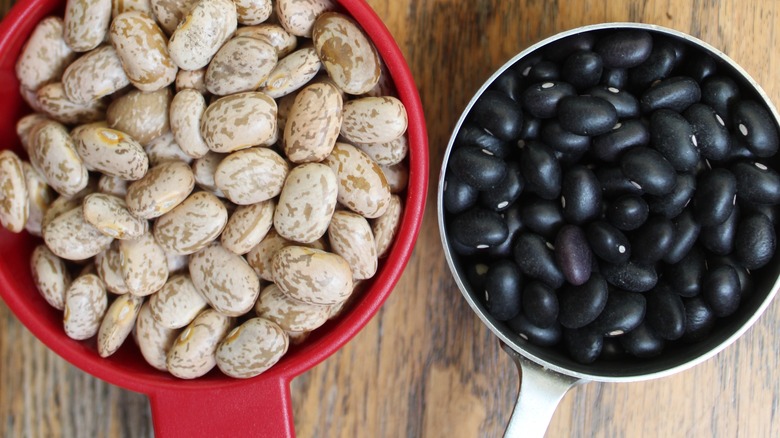Huge Mistakes You're Probably Making With Canned Beans
When it comes to all of the wonderful bounties Mother Nature has bestowed upon us, beans are surely one of the greatest — and most delicious. These potent superfoods don't just taste amazing, they're also packed with nutrients like protein, folate, iron, potassium, magnesium, and a hefty dose of fiber.
Beans can be used in an amazingly vast array of dishes and recipes, both comforting and versatile. And thanks to the convenience of canned beans, you don't even have to soak them overnight or go through all that tedious prep that generations before us had to endure before they could sit down to their favorite bean-infused plate of food.
But be forewarned. Even though canned beans are incredibly quick and easy to use in the kitchen, if you're just popping the top on that can and then pouring the contents straight into whatever you're cooking, that's a problem. You're making one (or more) huge mistakes with every can of beans you down. To find out just what those mistakes might be and how to avoid repeating them in the future, keep reading.
Not rinsing the beans thoroughly
Canned beans aren't like canned soup or canned fruit. You shouldn't just use them exactly as they come out of the can: You always need to rinse them first.
Rinsing canned beans has value — and should be a regular part of your meal prep routine — for several reasons. For starters, the liquid that plain canned beans are preserved in typically has a very high amount of salt, and if you pour that liquid into your rustic homemade chili or zesty taco filling, it's going to end up tasting way too salty. Rinsing the beans helps to lower their sodium content and adds less salt to your already-salty dishes.
But even low-sodium canned beans need to be rinsed. That's because rinsing also helps to remove any residue or impurities that might have been collected on the legumes while they were in the can. This can help to keep your bean dishes from ending up chalky or tasting like tin — a common problem for many lower-priced canned foods in particular.
Finally, and perhaps most importantly, rinsing beans can help to keep you from feeling gassy after eating them. Complex sugars in beans are a known trigger for gas and bloating. Rinsing beans in cool water after you open them can help to remove some of those sugars — which is not only better for your digestion but also for the comfort of those around you (and anyone you might be serving).
Underestimating their sodium content
So, canned beans are salty. You might be thinking: Aren't lots of things? But it turns out that canned beans really are a top contender when it comes to packing more sodium than most of us expect. A single serving of canned navy beans can contain 900 milligrams of sodium. Canned baked beans, canned Lima beans, and canned kidney beans are nearly as salty, coming in at more than 800 milligrams of sodium per serving, on average.
For easy comparison, that's approximately the same amount of sodium as you'd get from a small plate of tortilla chips with nacho cheese, two thin slices of ham, or one large salted pretzel. To cut down on that sodium in a significant way and keep your bean-filled recipes from being overly salty, The Bean Institute — a cooperative made up of many of the country's top beans growers and providers — advises that you "first, drain beans in a colander for two minutes. Then rinse the beans under cool running water for 10 seconds. Let drain for another two minutes." By doing this, the group says, you can reduce the amount of sodium in the beans you are cooking with by as much as 40%.
Overcooking your canned beans
After being harvested, beans go through a number of steps before they end up in the can. They're sorted, cleaned, and then partially cooked. Next, the now tender beans are poured into sterile cans that are then topped off with water or brine. Finally, the cans are sealed and put through heat processing or vacuum sealing.
This process is not only what makes canned beans so convenient — it's also what ensures they can stay sitting in a can on your shelf (for years if needed) before they are finally used. Why did we break this whole canning cycle down? Because it's important to remember that canned beans have already been cooked. They're soft and ready to eat. They just need warmed back up or brought to the same temperature as the rest of the dish you are serving them with.
So if you're recooking your canned beans when you use them, you're making a definite mistake. That extra heat exposure zaps away valuable nutrients. It can change the texture of your beans and reduce their firmness — or even make them mushy. It can also change the flavor of the beans, making them taste bland or waterlogged. Some people say overcooking can even make canned beans give off an unpleasant odor. The moral of the story? Don't do it. Add them as late as you can in the cooking process whenever possible. And expose them to heat just long enough to get nice and warm.
Throwing away that aquafaba
If you follow a plant-based diet, there's a chance you may have come across mentions of "chickpea water" or aquafaba before. But if you've never heard of it in the past, you're definitely not alone. Aquafaba quite literally means "bean water" and that's exactly what it is — the water in the can that your beans are swimming in.
We mentioned previously that beans should always be drained and rinsed before use. And while you could throw your aquafaba away, there are also a surprising number of things you can do with it as well that might warrant saving it instead. The slightly slimy liquid, which some have compared to the consistency of egg whites, is actually a popular vegan substitute for eggs in both cooking and baking.
You can use 3 tablespoons of aquafaba as a replacement for an egg in many recipes for cakes, cookies, and other baked goods. Aquafaba can also serve as a base for homemade plant-based mayonnaise. Simply combine it with oil, mustard, vinegar, and seasoning and whisk until creamy.
Because it can be whipped to stiff peaks — like heavy cream — aquafaba can also be used to make meringues for pies. You can even add it to pancake or waffle batter to give these breakfast staples a lighter, fluffier texture when they come off the griddle. Want to really blow your mind? Some companies even use aquafaba to make vegan ice cream, because of its smooth, creamy consistency.
Always buying the same type of canned beans
Whether it's local restaurants, types of books you enjoy, and even the genre of music you listen to, having a favorite you stand by is great. But also don't forget the importance of variety and trying new things from time to time. The same idea is true when it comes to ingredients, and beans in particular.
Just because you grew up in a house where your mom only served kidney beans, or you really enjoy the nutty flavor of garbanzos, that doesn't mean you should make the common mistake of only stocking your pantry with one type of canned bean exclusively.
Black beans are great for their earthy slightly sweet taste and creamy texture. They're ideal for everything from stews and soups to filling for Mexican favorites like tacos or burritos or even a showstopping side like beer beans — if you haven't tried it before, you need to.
Kidney beans are starchier and have an even sweeter taste, making them ideal for chili or a wide variety of Mediterranean dishes. Chickpeas are great for hummus, but their hearty, grainy texture also helps them shine in stews and curries. Cannellini beans are uber creamy and perfect with pasta or in a salad. Navy beans have a light, mild taste and wonderfully absorb the flavors of foods they're cooked with. You've also got lentils, adzuki beans, red beans and so many more to explore and enjoy.
Using too little or too much seasoning with your canned beans
You may see a selection of beans in your local market that come pre-flavored with a variety of spices, like "chili beans" for example. These flavorful options are pre-seasoned and can pack wonderful flavor. In this case, don't drain or rinse your beans before use — these are beans you can pour directly into whatever you may be cooking.
But also keep in mind that the vast majority of beans you'll see in the canned food aisle are not flavored or spiced. Aside from salt, these beans don't have any other flavorings added, so you'll need to work your magic with them to make them a flavorful part of your meal. Luckily, beans take on the flavor of different spices exceptionally well.
For a more savory bowl of canned beans with nothing else added beyond spice, try stirring in ½ to 1 teaspoon of garlic powder or onion powder. For warmth and earthiness, try adding the same amount of cumin. One teaspoon of smoked, sweet, or hot paprika can add mild smokiness and heat to your beans. For a bit of a herbal, floral kick, try ½ teaspoon of added oregano or thyme. And your options keep going on from there. You can also pair your beans with coriander, mustard powder, rosemary, ginger, turmeric, celery seed, and so much more. In each case, start with ½ teaspoon first, give the beans a taste, and then add more as needed.
Putting leftover beans in the fridge while still in the can
We've all been there. Perhaps you were making a soup but only needed half a can of beans. Or you wanted some beans to mix into a pasta dish but only needed a few spoonfuls. Whatever the reason, your meal is ready, but now you're stuck with half a can of unused beans to figure out what to do with. While the easiest solution might be just to shove that partially emptied can into the fridge and figure out what to do with those beans later, don't do it. That's a huge culinary mistake for many reasons.
For starters, once you open a can and expose the contents to fresh air, all sorts of different chemical reactions begin to occur. With beans and other canned foods alike, that chemical reaction can start to alter the taste of your food — giving it a slightly metallic flavor. It can also cause parts of the metal to begin to leach into your food, creating potential food safety issues.
Stored leftover food in an open can in your fridge also exposes your food to potential bacterial infection. And even if your leftover beans remain completely safe, they can begin to dry out in the fridge, impart their odor to other foods, or they can take on the odors of other foods you also have in the fridge. And either option is sure to leave your fridge smelling extra funky.
Not using canned beans in salads
We commonly associate beans with savory entrées or sides — chili, Mexican food, or a wonderful pot of rainy-day winter minestrone. But if you only think about canned beans as ingredients for dishes you prepare in the oven or on the stovetop, you're missing out — and making another huge kitchen blunder because canned beans are an exceptional ingredient for all kinds of fresh and green salads.
Adding canned beans to your salad can be as simple as tossing a few tablespoons of kidney beans or garbanzo beans into a green salad of romaine, arugula, diced tomato, cucumber slices, and a handful of freshly chopped herbs. Or, throw together a classic three-bean salad. You can use kidney, garbanzo, wax, black, or even cannellini beans. Pair them with diced red onion, bell pepper, celery, and top with a dressing made with white vinegar, olive oil, and Dijon mustard.
But don't let your salad-making end there, either. For a tasty Mediterranean-style salad, you can also combine chickpeas, cherry tomatoes, cucumber, red onion, Kalamata olives, and Feta cheese. Canned black beans, frozen corn, red bell pepper, red onion, avocado, and a dash of lime intermingle wonderfully for a tangy Mexican corn salad. For a taste of Italy, mix canned cannellini beans, cherry tomatoes, onion, fresh mozzarella, and basil into a delicious salad you can pair with almost anything. And don't forget that canned beans are also great added to pasta salads, tuna salads, and more.
Not combining canned beans with your ground beef
Beans and beef are the culinary equivalent of Han Solo and Chewbacca, Batman and Robin, and Trixie and Katya — they go together perfectly. Because of this, even dishes that don't typically call for the use of canned beans can benefit from their addition—mixing canned beans into ground beef-based dishes like sloppy joes, spaghetti bolognese, enchiladas, stuffed peppers, and more yields many incredible benefits.
For starters, beans add flavor and bulk to these dishes, making them heartier and even more tasty. Beans also help to expand the size of the dish so you can serve more people for relatively the same cost — great if you're cooking on a budget or have a big and hungry family. Finally, and perhaps most importantly, adding beans to ground beef-based dishes adds fiber and protein to your meals while also helping to lower fat and calorie levels, making your meals healthier overall.
And working the canned beans into any of these dishes couldn't be easier. Simply drain and rinse your beans. Then, when you are browning your ground beef, add them near the end of the cooking process, right before you drain your beef and combine it with other ingredients. You can add the beans whole, but you should also consider mashing them, which is an excellent option if you want a smoother texture or are serving picky eaters who might turn up their noses at finding a bean mixed into their beef.
Thinking canned beans are only for savory dishes
If you don't often think of using canned beans in salads, then you're forgiven for not thinking of the many different ways that beans can be included in sweets. But guess what; they can be. In fact, canned beans are an excellent substitute to fit in any number of baked goods and desserts. And while working beans into these desserts won't often have much, if any, impact on their flavor, it helps in innumerable other ways. Beans can make desserts moister, creamier, and even more nutritious — higher in fiber, lower in sugar, and dramatically lower in calories as well.
For example, swap 1 cup of black bean purée instead of 1 cup of flour in your favorite recipe to make black bean brownies with an almost fudge-like consistency. You can do the same thing with garbanzo beans and cookies. Substitute 1 cup of chickpea purée for 1 cup of flour for cookies with a rich, intense, natural, nutty quality.
To make kidney bean chocolate cake, you guessed it: Cut 1 cup of flour from your go-to cake recipe and use 1 cup of kidney bean puree instead. Making a white cake? Use ½ cup of pureed cannellini or navy beans in place of ½ cup of butter or oil. You can even make lower-calorie, higher-fiber muffins with lentils. Simply swap ½ cup of cooked and mashed lentils in place of an equal amount of flour.
Substituting wrong when using canned beans in place of dry
Ready to head to the kitchen and start whipping up a bounty of bean-filled dishes? Good. But before you go, there's one more common and easily made canned bean mistake many of us make that you should also be aware of. This one is all about math and how we might substitute canned beans with dry beans in recipes and vice versa.
The critical thing to remember is that canned and dry beans are not interchangeable when cooking. Yes, you can use canned beans when a recipe calls for dry. And dry beans can be swapped for canned if that's all you have on hand. But the quantities you use for these substitutions are not equal. Canned beans contain more water and have more volume than dried beans. So, if a recipe calls for 1 cup of dried beans, you should plan on using 1½ to 2 cups of canned beans as a substitute.
Also, be prepared to make some adjustments to your cooking time. Dried beans can take anywhere from 45 minutes to two hours of cooking time to become tender. Canned beans are already tender, so they will require significantly less cooking time overall, and you will need to account for this with whatever recipe you might be making. But the good news is that your meal will be ready faster — and who doesn't want that?

